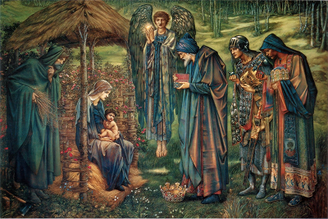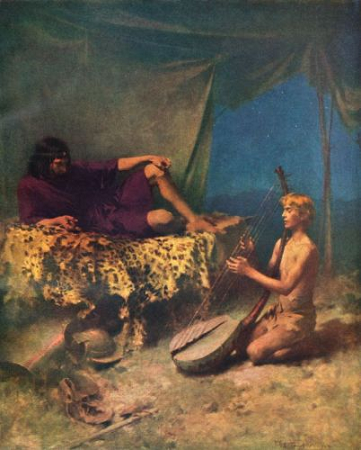
One Saint continues with selected quotations from Ernest L Martin's work, The Star of Bethlehem: The Star that Astonished the World.
You can read or listen to The Star of Bethlehem: The Star that Astonished the World at the ASK ELM website.
You can also listen to David Sielaff’s wonderful audio interview with George Ann Hughes at the Byte Show. These files bring us up to date, for David Sielaff continues the work of Ernest L Martin today. You will find the full interview at The Byte Show. Scroll way down to The Star of Bethlehem series, in fourteen parts.
You can also listen to all eleven parts of The Star of Bethlehem interviews Ernest L Martin did with Jeff Rense at ASK ELM:
Following are excerpts from The Real Star of Bethlehem (Chapter Four)...
"...The Magi focused on Judaea and not Rome at this crucial time in history.
"Let us look at some of the astrological and biblical factors that may have brought the Magi to Jerusalem and then to Bethlehem. Since the New Testament says the Magi saw the “star” rising in the east, it would most naturally be called a “morning star.” The Book of Revelation has Jesus saying of himself, “I am the root and offspring of David, and the bright and morning star.” 1 The apostle Peter also mentioned that Jesus was symbolically associated with “the day star.” 2
"The above verses refer to celestial bodies that were well known and recognized in the 1st century and they inspired symbolic messianic interpretation by early Christians. There were several prophecies in Isaiah which generally were interpreted as referring to the Messiah. One has definite astronomical overtones to it. Isaiah said, “The Gentiles shall come to thy light, and kings to the brightness of thy rising.” 3 This prophecy could easily refer to the rising of some star. It would be particularly appropriate to a “morning” or “day” star. Luke, in his Gospel, referring to the celestial symbolism of Isaiah 60:3 which spoke of God as being “the daybreak [the rising] from on high that hath visited us, to give light to them that sit in darkness.” 4
"These references reveal that celestial bodies were symbolically important to the New Testament writers. We know that the generality of the world was then engrossed with such symbolic concepts. The rising of a star or planet just before sunrise was particularly significant in interpreting events relating to important people. And Luke in his Gospel refers to Jesus as a star which will bring great light to all the world.
"With this in mind, let us recall from our first chapter that on morning of August 12, 3 B.C.E. (about an hour and twenty minutes before sunrise), Jupiter rose as a morning star in conjunction with Venus..."
DR Martin continues to delve into the astronomical happenings of the day: the "Grand Astronomical Displays... Signaling the Birth of a King," "The King Planet... And More Spectacular Signs."
But what about the "star that stood still?"
"It is this description of the star standing still that has caused many interpreters to characterize the whole episode in Matthew as either fictitious or a miraculous event. Most people find it difficult to imagine a normal heavenly body having the capability of stopping its movement over a small village in Palestine. At first thought, a person might agree that such a thing appears impossible. But maybe the account is not as ridiculous as it may seem. In truth, there is not the slightest difficulty for such a thing to happen.
"The truth is, Matthew was simply describing a celestial phenomenon in popular language that all astronomers and persons acquainted with basic planetary motions would have been fully aware. Planets do come to a “stop” at prescribed times in their heavenly motions. This happens at the time for a planet’s retrogression and progression. It may be that Matthew was simply showing that Jupiter had become stationary in its motions through the fixed stars at the time it reached its zenith over Bethlehem."
Further, it was the winter solstice. Martin cites:
"“General observance required that on the 25th of December the birth of the ‘new Sun’ should be celebrated, when after the winter solstice, the days began to lengthen and the invincible star triumphed again over darkness.” 28
Martin then focuses upon the Interpretation of the Magi, Jewish Feast of Hanukkah and describes how the "Whole Jewish Nation Was in Celebration." He concludes with the Magi giving "Their Gifts At Hanukkah."
"What we find in this unique calendar circumstance is that the Jews were seeing Jesus as the Messiah by having the Magi give their gifts in the midst of their celebration of Hanukkah, while the heathen peoples in the world were seeing the Magi represent them at the time of their Winter Solstice celebrations. It is interesting that these festival occasions occurred in combination to one another in that year. Jewish and pagan celebrations combined for that year."
We continue to celebrate the birth of Our Lord and Savior Today.
___________
Martin, Ernest L. “The Star of Bethlehem: The Star that Astonished the World.” 19 DEC 2012. <http://www.askelm.com/star/star004.htm>
You can purchase the hardbound version of The Star of Bethlehem: The Star that Astonished the World, by DR Ernest L Martin at amazon.com.

 RSS Feed
RSS Feed